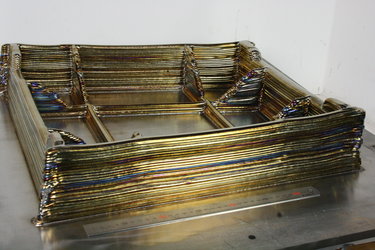Accept all cookies Accept only essential cookies See our Cookie Notice

About ESA
The European Space Agency (ESA) is Europe’s gateway to space. Its mission is to shape the development of Europe’s space capability and ensure that investment in space continues to deliver benefits to the citizens of Europe and the world.
Highlights
ESA - United space in Europe
This is ESA ESA facts Member States & Cooperating States Funding Director General Top management For Member State Delegations European vision European Space Policy ESA & EU Space Councils Responsibility & Sustainability Annual Report Calendar of meetings Corporate newsEstablishments & sites
ESA Headquarters ESA ESTEC ESA ESOC ESA ESRIN ESA EAC ESA ESAC Europe's Spaceport ESA ESEC ESA ECSAT Brussels Office Washington OfficeWorking with ESA
Business with ESA ESA Commercialisation Gateway Law at ESA Careers Cyber resilience at ESA IT at ESA Newsroom Partnerships Merchandising Licence Education Open Space Innovation Platform Integrity and Reporting Administrative Tribunal Health and SafetyMore about ESA
History ESA Historical Archives Exhibitions Publications Art & Culture ESA Merchandise Kids Diversity ESA Brand Centre ESA ChampionsLatest
Space in Member States
Find out more about space activities in our 23 Member States, and understand how ESA works together with their national agencies, institutions and organisations.
Science & Exploration
Exploring our Solar System and unlocking the secrets of the Universe
Go to topicAstronauts
Missions
Juice Euclid Webb Solar Orbiter BepiColombo Gaia ExoMars Cheops Exoplanet missions More missionsActivities
International Space Station Orion service module Gateway Concordia Caves & Pangaea BenefitsLatest
Space Safety
Protecting life and infrastructure on Earth and in orbit
Go to topicAsteroids
Asteroids and Planetary Defence Asteroid danger explained Flyeye telescope: asteroid detection Hera mission: asteroid deflection Near-Earth Object Coordination CentreSpace junk
About space debris Space debris by the numbers Space Environment Report In space refuelling, refurbishing and removingSafety from space
Clean Space ecodesign Zero Debris Technologies Space for Earth Supporting Sustainable DevelopmentApplications
Using space to benefit citizens and meet future challenges on Earth
Go to topicObserving the Earth
Observing the Earth Future EO Copernicus Meteorology Space for our climate Satellite missionsCommercialisation
ESA Commercialisation Gateway Open Space Innovation Platform Business Incubation ESA Space SolutionsLatest
Enabling & Support
Making space accessible and developing the technologies for the future
Go to topicBuilding missions
Space Engineering and Technology Test centre Laboratories Concurrent Design Facility Preparing for the future Shaping the Future Discovery and Preparation Advanced Concepts TeamSpace transportation
Space Transportation Ariane Vega Space Rider Future space transportation Boost! Europe's Spaceport Launches from Europe's Spaceport from 2012Latest

Ins and outs of 3D printing
Thank you for liking
You have already liked this page, you can only like it once!
This is a prototype 3D-printed and partly machined test item, to investigate methods of producing complex metal parts for space.
An ESA-led project 3D produced this test structure to evaluate a promising method called plasma metal deposition. A hot plasma plume renders metal into molten drops, to be laid down as needed.
A total of six test parts were produced using this method, undertaken by RHP Technology GmbH in Austria, working with AAC Aerospace and Advanced Composites and FOTEC Forschungs- und Technologietransfer GmbH.
“The goal of this project was to assess the ability of the technique for the manufacturing of space hardware and components with size larger than 0.5 m,” explains ESA materials engineer Laurent Pambaguian. “We investigated the entire process chain, including follow-up heat treatment and post-processing machining as well as 3D printing, using titanium alloy as either metal particles or wire feedstock.
“The result demonstrates good mechanical properties and finishing, meaning we are able to take the technology forward, including the investigation of alternative materials. Plasma metal deposition is a candidate method to manufacture large sized components in the future, such as the optical bench of the Athena mission, which will be the most complex part ever printed in titanium.”
This project has been supported through ESA’s Technology Development Element as part of the Agency’s Advanced Manufacturing initiative, harnessing novel materials and processes for the space sector.
-
CREDIT
RHP/Robert Syrovatka -
LICENCE
ESA Standard Licence

Recycling parts for life on the Moon

Metal 3D-printed Ariane launcher bracket

Move over plastic: desktop 3D printing in metal or ceramics

3D-printed aeronautics demonstrator















 Germany
Germany
 Austria
Austria
 Belgium
Belgium
 Denmark
Denmark
 Spain
Spain
 Estonia
Estonia
 Finland
Finland
 France
France
 Greece
Greece
 Hungary
Hungary
 Ireland
Ireland
 Italy
Italy
 Luxembourg
Luxembourg
 Norway
Norway
 The Netherlands
The Netherlands
 Poland
Poland
 Portugal
Portugal
 Czechia
Czechia
 Romania
Romania
 United Kingdom
United Kingdom
 Slovenia
Slovenia
 Sweden
Sweden
 Switzerland
Switzerland

























